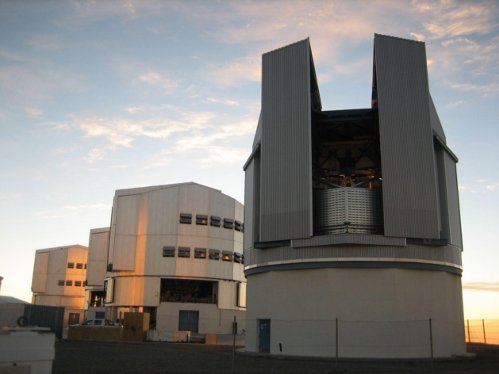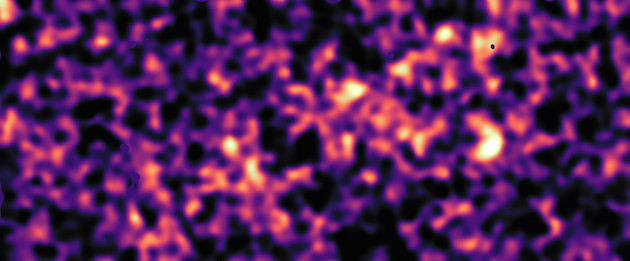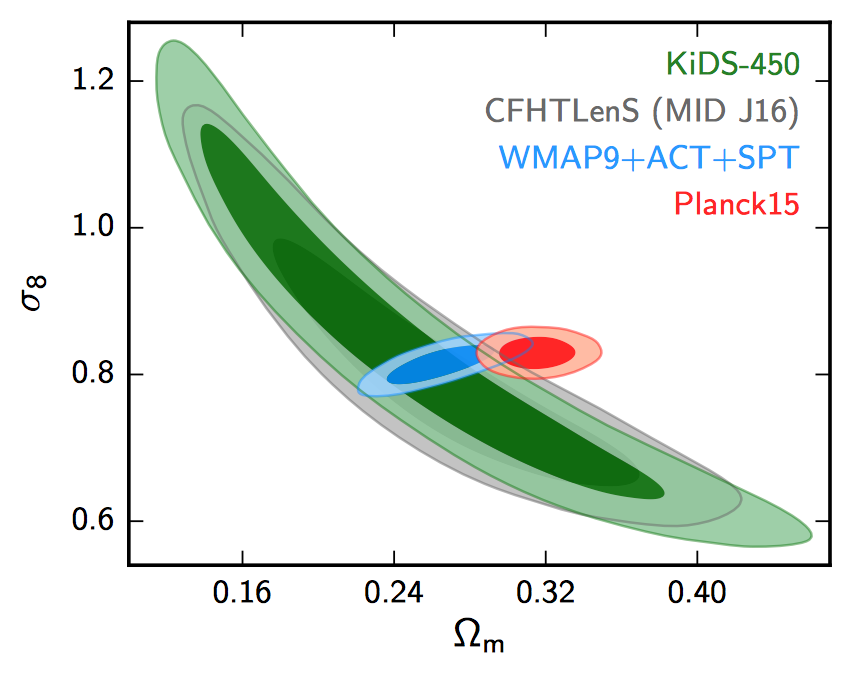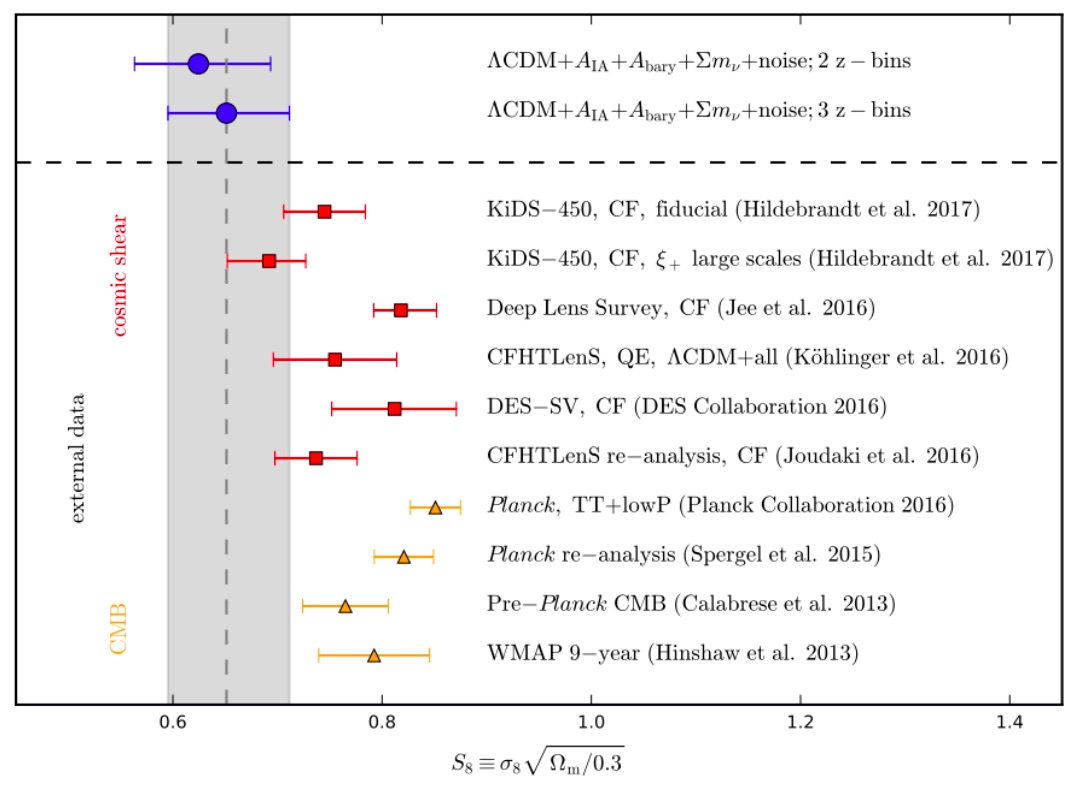The Kilo-Degree Survey

KiDS, the Kilo-Degree Survey, is a large optical imaging survey in the Southern sky, designed to tackle some of the most fundamental questions of cosmology and galaxy formation of today. Using the VLT Survey Telescope (VST), located at the ESO Paranal Observatory, KiDS has mapped 1350 square degrees of the night sky in four broad-band filters (u, g, r, i).
Contact
Email:
kids_at_strw.leidenuniv.nl
Postal address:
KiDS survey
attn: K. H. Kuijken
Sterrewacht Leiden
P.O. Box 9513
NL-2300 RA Leiden
The Netherlands
A joint cosmic shear analysis of the Dark Energy Survey and KiDS
19 Sep 2023
KiDS and DES have joined forces to re-analyse the cosmic shear measurements from DES Year 3 and KiDS-1000. Together we defined a Hybrid analysis pipeline, selecting a unified framework for intrinsic alignment models, baryon feedback mitigation strategies, priors, samplers and models of the non-linear matter power spectrum. Our results are consistent with S8 constraints from observations of the cosmic microwave background by Planck, with agreement at the 1.7σ level.
For more information, watch our Cosmology Talk, read our Paper or download the data products.
KiDS-1000 weak lensing data products available
8 Dec 2020
The data products from KiDS-1000, the weak lensing analysis of the KiDS DR4 data, are now available for download. This released data includes the galaxy shapes/photometry catalogue, 2-point shear statistics data vectors and covariance matrices, and parameter posterior samples. For more details and links to the data see the dedicated KiDS-1000 lensing pages, or follow the "Additional data products" link under the "Data access / KiDS DR4" drop-down menu at the top of this page.
The Universe Is More Homogeneous Than Expected
31 Jul 2020
New results from the Kilo-Degree Survey (KiDS) show that the universe is nearly 10 percent more homogeneous than the Standard Model of Cosmology (Λ-CDM) predicts. The latest KiDS map was made with the OmegaCAM on ESO's VLT Survey Telescope at Cerro Paranal in Northern Chile. A group of astronomers led from institutes in the Netherlands, Scotland, England and Germany have described the KiDS-1000 result in five articles, the last three of which appeared online today. They have been submitted for publication in the journal Astronomy & Astrophysics. The press release highlighting these results can be found via the Press releases page or the link below.
 |
A zoom-in on a part of the KiDS-1000 density map, showing a patch of the Universe approximately 1.5 x 1 billion lightyears across. The grey square shows the size of an individual KiDS image, with a full moon for scale. Credit: B.Giblin, K.Kuijken and the KiDS team. |
KiDS-1000 Cosmology Live Webinar
28 July 2020
We thank everyone for joining the KiDS-1000 Cosmology Webinar! For anyone who missed it, the full Webinar is now available on YouTube. The papers can also be previewed from our from our KiDS-1000 pre-prints page.
How heavy is the Universe?
12 May 2020
Scientific American has published an article titled "How heavy is the Univers? Conflicting Answers Hint at New Physics", based largely on an interview with KiDS co-lead Hendrik Hildebrandt. The article discusses how the tension between the measurements of σ8 from weak lensing surveys such as KiDS and those of the Planck cosmic microwave background results may indicate the standard model of cosmology may be breaking down. There is still a 1% chance this tension is a statistical fluke, and the only way to solve this issue is by increasing the measurement accuracy. The upcoming analysis of the full survey area will allow the KiDS team to do exactly this.
KiDS Data Release 4 available
28 Feb 2019
The fourth public data release (DR4) of KiDS is as now available. This new release supercedes all previous releases and provides reprocessed pixel and catalog data products for a total of 1006 survey tiles, or roughly 1000 square degrees of the sky. New in the DR4 multi-band catalog is the inclusion of near-infrared VIKING data, thus providing photometric measurements for a total of 9 broadband filters (ugriZYJHK). Further details, the release notes, and data access information can be found on the DR4 website.
First KiDS+VIKING cosmic shear analysis
16 Dec 2018
The first cosmological measurement based on a combination of KiDS (optical) and VIKING (infrared) data has been presented in Hildebrandt et al. (2018). The area (450 sq.deg.), depth, and wavelength coverage of this first KiDS+VIKING data set make it the most extensive optical+infrared data set ever used for lensing measurements. Based on greatly enhanced photometric redshifts and new image simulations (Kannawadi et al. 2018) this analysis updates the KiDS-450 cosmology results from Hildebrandt et al. (2017) and significantly increases the systematic robustness.
The KiDS-450 weak lensing power spectrum
12 Jun 2017
We use 450 sq. deg. of KiDS imaging data to measure the weak gravitational lensing shear power spectrum with a quadratic estimator in two and three redshift bins. The cosmological parameter that is best constrained by the cosmic shear power spectrum data is a combination of the total matter density Ωm and the clustering amplitude σ8 called S8=σ8*√(Ωm/0.3). The constraints derived for this analysis confirm the recently reported tension in this parameter combination with constraints from the Planck cosmic microwave background probe at 3.2σ (we compare also to other data sets in the Figure).
→ Paper on arXiv
→ Data products from this analysis
Finding galaxy clusters in KiDS
7 Feb 2017
The first galaxy cluster catalog from KiDS, based on the DR2 data set, has been published in Radovich et al. (2017, A&A, 598, A107). Accompanying the paper is a catalog of 1585 candidate clusters, extending to a redshift of 0.7, and shown to be 85% complete, with an estimated purity of 80%. This catalog can be downloaded from the cluster catalog webpage linked below. The tools (developed by F. Bellagamba, M. Maturi and M. Roncarelli) that have been used to harvest the KiDS data for galaxy clusters and presented in this paper, have also been selected for use by the upcoming ESA Euclid satellite mission.
→ Paper on A&A website
→ DR2 cluster catalog webpage
 |
Central 2 arcsecond region of the cluster Abell 1411, one of the rich clusters present in the KiDS DR2 area. This color image was made from KiDS u-, g- and r-band data and shows the Brightest Cluster Galaxy, indicated by the green circle; the red circle shows the cluster center reported in the Abell catalog. |
KiDS goes to the Galaxy Zoo
1 Feb 2017
Images from the Kilo-Degree Survey (KiDS) are now included in the Galaxy Zoo citizen science project, where anyone can help classify galaxies and contribute to our astronomical knowledge. Currently, for over 11,000 galaxies, selected based on a galaxy catalog from the GAMA survey, color images from KiDS g-, r- and i-band data are available. This data set will later on be extended step-wise to over 40,000 galaxies. The high quality KiDS images will allow us to study the very faintest structures within galaxies, as well as more accurately classify features which may have been missed before.
→ Galaxy Zoo
→ Blog post: New images for Galaxy Zoo from GAMA-KiDS!
KiDS-450 Weak lensing shear catalog released
3 Jan 2017
The weak lensing shear catalog for the KiDS-450 / DR3 data set, covering 454 KiDS survey tiles is now publicly available. This data set serves as the basis for the cosmic shear analysis presented in Hildebrandt & Viola et al. (2017) and various more scientific analyses currently in preparation. Available both via ESO and CADC, the catalog provides accurate shear measurements and photometric redshifts for over 15 million galaxies.
Dark matter may be smoother than expected
7 Dec 2016
Analysis of 450 square degrees of the Kilo-Degree Survey (KiDS), made with ESO's VLT Survey Telescope in Chile, suggests that dark matter may be less dense and more smoothly distributed throughout space than previously thought. An international team studied how the light from about 15 million distant galaxies was affected by the gravitational influence of matter on the largest scales in the Universe. The results appear to be in disagreement with earlier results from the Planck satellite. Press releases highlighting these results can be found via the Press releases page.
 |
Dark matter map of KiDS survey region (region G15). Credit: Kilo-Degree Survey Collaboration/H. Hildebrandt & B. Giblin/ESO. |
KiDS Data Release 3 available
10 Oct 2016
The third public data release (DR3) of KiDS is as now available. Adding 292 survey tiles to the previous releases, DR3 brings the total number of released tiles to 440. New features in the DR3 multi-band catalog, which covers the combined survey area of DR1, DR2 and DR3, are Gaussian Aperture and PSF (GAaP) photometry, survey photometric homogenization, and photometric redshifts. Further details, the release notes, and data access information can be found on the DR3 website.
KiDS measures cosmic shear from 15 million galaxies
16 June 2016
Based on 450 square degrees of imaging, we have obtained the first cosmological parameter constraints from KiDS. The main result is shown in the Figure, in the form of constraints on the σ8 - Ωmatter plane. Interestingly, and in common with many other low-redshift probes, the best-fit values show a discrepancy with the expectation from Planck cosmology. Further studies are underway.
→ KiDS-450 paper and data access
 |
Constraints in the Ωm vs. σ8 plane from KiDS-450 cosmic shear tomography (green) in comparison to CFHTLenS (gray), WMAP9+ACT+SPT (blue), and Planck 2015 (orange). |
Dutch broadcaster VPRO interviews Margot Brouwer
18 May 2016
Dutch broadcasting corporation VPRO interviewed Leiden University Phd student Margot Brouwer about her work on KiDS. The article, which is only available in Dutch, has been published in the VPRO tv guide, but can also be downloaded below. On Thursday May 19th at 19:20 CEST, a related documentary focused on the nature of Dark Matter will be broadcast on Dutch public tv station NPO2.
→ Donkere materie vangen
→ De Kennis van Nu: Special - Donkere Materie
First science results from KiDS published
6 Jul 2015
Today the first scientific results from the Kilo-Degree Survey have been published. Among the first batch of papers are early weak gravitational lensing analyses, demonstrating the power of the superb image quality of KiDS for this type of research. Other results presented include the discovery of four high-redshift quasars, a sample of super-compact massive galaxies, and a catalog of photometric redshift based on machine learning techniques. Links to the papers are provided on the Papers page, and press releases highlighting these first results can be found via the Press releases page.
 |
Animated gif of a group of galaxies, with and without the invisible dark matter rendered in pink. Credit: Kilo-Degree Survey Collaboration/A. Tudorica & C. Heymans/ESO |
Lensing catalogs available
6 Jul 2015
With the announcement of the first weak lensing analyses using KiDS data, the weak lensing shear catalogs are also released. The area covered is the overlap of the combined data set of the first two KiDS public data releases with the equatorial regions covered by the GAMA survey. Shear measurements are made using a dedicated pipeline using THELI and Lensfit, while the included photometry and photometric redshifts are derived from the DR1/2 coadded images using image gaussianization and Gaussian-weighted aperture photometry.
Please visit the Lensing catalogs page for details and data access.
KiDS Data Release 2 available
18 Feb 2015
The second public data release of KiDS (KiDS-ESO-DR2) is available. It contains calibrated, stacked images and their weights, masks and single-band source lists for 98 square degrees, as well as a multi-band source catalog encompassing the 150 square degrees of the first two KiDS data releases combined. All data are available via the ESO archive facility, as well as via the AstroWISE Information System.
Please visit the KiDS Data Release 2 pages for details and data access.

